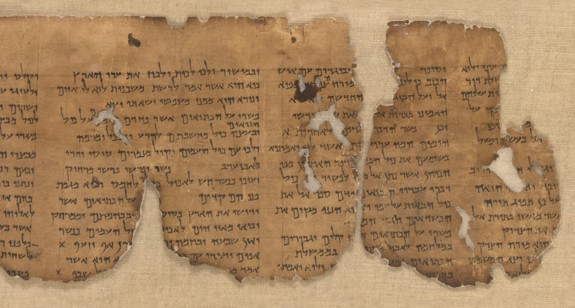Everyone seems to “love” the Dead Sea Scrolls though I fear, much like the Bible, few seem to have actually read them. Some years ago I remember a very enthusiastic woman who came up to me after one of my public lectures on this scrolls, exclaiming, “Dr. Tabor, I just love the Dead Sea Scrolls! I am so glad they are finally released to all of us.” I agree with her and asked her how much reading she had done of the Scrolls–especially the newly released ones. Her answer was classic: “Oh, I haven’t actually read the Scrolls yet–I am just so thrilled that we have them!”
There is nothing wrong with reading or hearing about the Dead Sea Scrolls, but such a study, even by non-specialists, should be done with one of the English translations at hand. In terms of academic rigor I would recommend the translation of my friend Florintino Garcia Martinez, The Dead Sea Scrolls Translated: The Qumran Texts in English. If you know a bit of Hebrew and Aramaic you can also get the special Dead Sea Scrolls Study Edition in two volumes, with facing pages in English and lots of good critical notes (sadly out of print but available through used book dealers). But the English translations alone are a great start. There is also the wildly popular Penguin paperback, The Complete Dead Sea Scrolls in English by the late Geza Vermes, how in its 7th revised edition.

I would further recommend the resource page at the Biblical Archaeology web site here, with its many links and good basic information.
For the more serious student of the scrolls I would then suggest the following books be read in this order:
Vanderkam and Flint, The Meaning of the Dead Sea Scrolls: Their Significance For Understanding the Bible, Judaism, Jesus, and Christianity. This will put one in the picture in terms of the basic facts related to the scrolls and offer one a good overview of what might be called the “standard” interpretation.
Lawrence Shiffman, Reclaiming the Dead Sea Scrolls: The History of Judaism, the Background of Christianity, the Lost Library of Qumran (The Anchor Yale Bible Reference Library).
Michael Wise, The First Messiah: Investigating the Savior Before Jesus
Robert Eisenman, The Dead Sea Scrolls and the First Christians: Essays and Translations, plus his various other works, see his web site here.
It is regrettable that many of my colleagues have ignored or marginalized Eisenman’s work on the Scrolls, usually without even giving his books a careful read. Eisenman’s fresh, non-traditional and non-theological translations, that show so clearly the parallels with the thought worlds of the Scrolls and that of the early Jesus/James movement. The standard charge that he thinks that “Jesus” or “James” are in the scrolls is a mis-characterization of his important work which I fear too few have actually read. [1]For example, Bart Ehrman, in his latest book, Did Jesus Exist, charges that Robert Price is “building upon the wildly speculative and widely discredited views of Robert Eisenmann (sic), in his … Continue reading What Eisenman has done well is to sketch out the major parameters of the apocalyptic, messianic “ways of thinking” common to the scrolls and earliest “Christianity,” as well as other similar sectarian movements in the period from the Maccabees to the Roman destruction of Jerusalem in 70 CE, with any arguments for or against a parallel chronology notwithstanding. Given the linguistic and conceptual parallels a text like the Habakkuk Pesher, found in Cave 1 in 1947, is one of the most important documents for an understanding of early Christianity one could study.









Comments are closed.